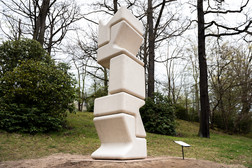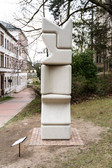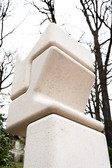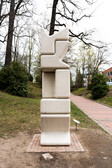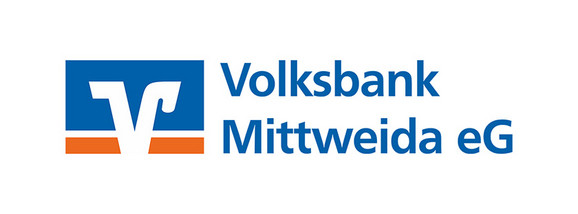Jeffrey James: Cumulus
Mittweida
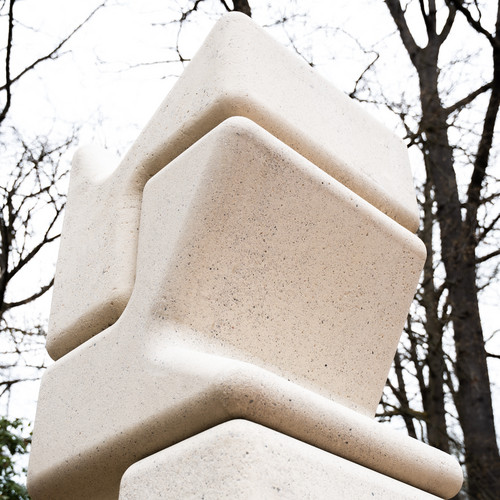
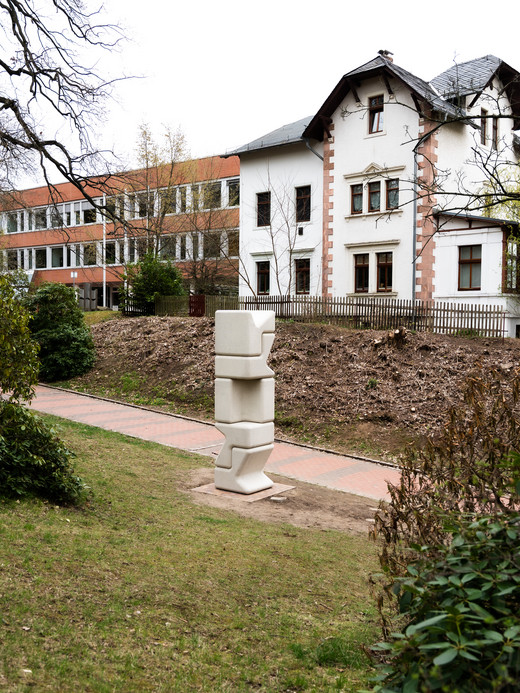
Five moulded concrete modules are assembled to form a slender column. Their angular, serially repeating forms, which are the result of technically generated processes, interlock perfectly and form a solid structure. With the title of the sculpture "Cumulus", the sculptor, architect and designer Jeffrey James, who was born in London in 1958 and now lives and works in Berlin, refers to the phenomenon of cumulus clouds: their imposing, fractal shapes, which are only held together by tiny drops of water, are in a state of constant, random change due to thermal winds and pressure conditions. In contrast, the sculpture, which weighs around six tonnes, is stable in its place at Mittweida University of Applied Sciences. No human being or changing weather conditions can move it from here.
The immovable sculpture "Cumulus" refers to the attitude of the university management in Mittweida during the National Socialist era. The cosmopolitan technical college, which educated many foreign and Jewish students, had enrolled Gerhard Neumann, who came from a Jewish manufacturing family and later became an engineer and Vice President of General Electrics, as a student as late as 1936. When the Nazis forced the university management to immediately de-register Jewish students in 1938, a notice on the university notice board in 1939 enabled Neumann to emigrate to China. From there, he eventually went to the USA and became the most famous alumnus of the Mittweida Technical Centre.
(Text: Alexander Ochs / Ulrike Pennewitz)
Jeffrey James
Cumulus (2024)
In Mittweida
Material: Sculpture made of 5 modules, cast concrete
Size: approx. 400 x 100 x 100 cm
Erected with the support of the city of Mittweida.
Address:
Traditionsweg of the Mittweida University of Applied Sciences
Technikumsplatz 17
09648 Mittweida
to the location on Google Maps
Mittweida - people and technology between cosmopolitanism and the experience of dictatorship
North of Chemnitz, in the Zschopau valley, lies the 800-year-old town of Mittweida. The development of the clothmaking and linen-weaving town was often set back by wars and major town fires in the Middle Ages and early modern times. With the connection to the Saxon railway network in 1852, Mittweida experienced rapid industrialisation in the second half of the 19th century. The metal and textile industries, mechanical engineering and electrical engineering were the core sectors. With its serial elements, Jeffrey James' sculpture CUMULUS evokes many associations with Mittweida's traditions in the fields of technical construction and engineering.
A house of innovation: the technical centre
The Mittweida Technical Centre, founded in 1867, was and still is closely linked to the development of industry Mittweida University of Applied Sciences for Technology and Economics. The privately run technical centre became known above all for its excellent standards in the up-and-coming engineering sciences. This attracted students from all over Europe and overseas. In the 1920s, the institute had 2,300 students; today there are around 5,800 (as of 2023). Graduates are highly sought after by top companies such as IMM electronics.
Famous graduates
The list of famous graduates reads like a who's who of technology and economic history: automobile designer August Horchwho built the leading brands Horch and Audi in Zwickau from 1904, Friedrich Opel, head of the technical office at OPEL-Werke Rüsselsheim, the Dane Jörgen Skafte Rasmussenfounder of Zschopauer Motorenwerke (DKW), the world's largest motorbike manufacturer from 1928, and Hans Bahlsen, Technical Director of the H. Bahlsen biscuit factory in Hanover.
Cosmopolitan spirit withstands the Nazi state for a long time
During the global economic crisis of 1929/30, the Mittweida Technical Centre ran into financial difficulties. After the National Socialists came to power in 1933, it was no longer possible to continue privately. The institute increasingly came under the influence of Nazi politics. in 1935, it was forcibly renamed the Mittweida School of Engineering. Despite this, the university tried to resist the repressive racial policies of the Nazi state for a long time. Jews were still able to enrol here until 1936 and study until 1938.
Victims and collaborators of the Nazi regime
One of them was Gerhard Neumann, who studied mechanical engineering here until 1938, then emigrated and later designed jet engines for supersonic aeroplanes at General Electric in the USA. Anyone studying the history of Mittweida University of Applied Sciences will see the lives of victims and profiteers of the Nazi regime intersect here.
While Jewish students such as Neumann had to flee first to China and then to the USA, the paths of the entrepreneurs Horch and Rasmussen led via Auto Union AG in Chemnitz (founded in 1932 from: Horch, Audi, DKW and Wanderer) to collaboration with the Nazi state. During the Second World War, armaments were manufactured here in Germany's first state-supported automobile company and forced labourers were employed in five satellite camps of the Flossenbürg concentration camp.
Chroniclers of dictatorships
The writer Erich Loest (1926-2013) spent his childhood in Mittweida in the 1930s. His books made him an important chronicler of the dictatorship experience in the Nazi era and the GDR, where he was imprisoned as a political prisoner from 1958 to 1964. Since the 1990s, the Mittweida historian Dr Erich Jürgen Nitsche (*1958) has dedicated himself to historical reappraisal and fruitful remembrance work. His achievements include, for example, rescuing the biographies and fates of Jews during the Nazi era from oblivion through meticulous archival work.
People in history: Constructing. Writing. Design.
The designer: Gerhard Neumann (1917-1997)
Gerhard Neumann was born in Frankfurt an der Oder in 1917, the son of a bedspring manufacturer. Although his family was Jewish, they did not practise their faith. He began studying mechanical engineering in Mittweida in 1936, but was de-registered in 1938 due to the Nazi racial laws. He emigrated to China in December 1939 and then volunteered for the US Air Force in 1942. After the war in 1945, Neumann was granted US citizenship.
As a mechanical engineer, he was in demand in the growing US aviation industry. in 1948, he began his career at General Electric, one of the largest corporations in the USA. In 1953, Neumann took over the aircraft propulsion department and even developed a new jet engine. in 1961, he was promoted to General Manager and managed 20,000 employees. From 1963 to 1979, he was even Vice President of the entire group. Numerous awards honoured his commitment as a developer and manager. in 1986 he was inducted into the National Aviation Hall of Fame in 1986.
The writer: Erich Loest (1926-2013)
Erich Loest's childhood and youth were characterised by the experience of dictatorship and war. He was ten years old when he was accepted into the Hitler Youth. The Nazi regime did not let go of him until the end: HJ-Fähnleinführer (1942), admission to the NSDAP (1944), attempted admission to the Waffen-SS (1944), enlistment in the Wehrmacht (1944). In the first chapters of his book "Durch die Erde ein Riß. Ein Lebenslauf" (1981), he recounts his experiences in retrospect.
These experiences had left traces that led him on the path to becoming a chronicler of his time. After the war, Loest completed his A-levels, joined the SED and worked for the Leipziger Volkszeitung. He made his literary debut with the book "Jungen, die übrig blieben" (1950). From the mid-1950s, he studied at the Leipzig Literature Institute.
Political and personal caesuras
The popular uprisings in the GDR in 1953 and in Hungary in 1956 turned Erich Loest into a critic of dictatorships. He openly called for the democratisation of socialism and was thus targeted by the MfS - Ministry for State Security (Stasi). Loest was arrested in November 1957 and sentenced to seven and a half years in prison in December 1958 after 13 months on remand and a trial. He served his sentence for "counter-revolutionary group formation" as a political prisoner in the notorious Bautzen II prison until September 1964.
During these seven years in prison, he was not given any writing material to continue working as an author. After his release from prison, he was allowed to work as a writer again in Leipzig, writing novels, including crime novels, and short stories. Further confrontations with the GDR regime were inevitable due to Loest's critical stance.
Out of the confines of the GDR
In the novel "Es geht seinen Gang oder Mühen in unserer Ebene" (1978), he recounts the life of engineer Wolfgang Wülff in Leipzig. He relentlessly exposes the contradictions between appearance and reality in the GDR: the harassment of young people during the Beatles wave, the decay of the neighbourhoods, the abuses in the state-owned enterprises, the disillusionment of the people, the confrontation between power and people under socialism.
The censors wanted to prevent further distribution of the book. But during a reading tour in West Germany, Loest had already sold the book to a publisher in Stuttgart without official permission. The book was a great success, much to the displeasure of the GDR officials. This was followed by expulsion from the GDR Writers' Association. This renewed professional ban was the last straw for Loest. He applied to leave the country in 1981 and went to the West.
Rehabilitation and novel
A few months after the fall of the Wall, in April 1990, Erich Loest was rehabilitated by the Supreme Court of the GDR. From then on, he took up his second residence in Leipzig. He wrote about the events of the Peaceful Revolution in Leipzig in 1989 in his novel "Nikolaikirche" (1995), which was also made into a film based on his screenplay. Loest supported the establishment of the Bautzen memorial, was made an honorary citizen of Mittweida and Leipzig and received an honorary doctorate from Chemnitz University of Technology. He remained controversial until the end, when he ended his own life in 2013 after falling seriously ill.
The municipal library at Technikumplatz 1a in Mittweida is hosting an Erich Loest exhibition with many personal items that the author gave to his hometown back in the 1990s.
The sculptor: Johannes Schilling (1828-1910)
Johannes Schilling was born in Mittweida in 1828. When he was one year old, the family moved to Dresden. He received a basic education at a public school and the Dresden Art Academy, which he attended from the age of 14. His career as a sculptor was influenced by classicist masters such as Ernst Rietschel (Dresden), Christian Daniel Rauch (Berlin) and Ernst Julius Hähnel (Dresden).
When Schilling opened his own studio in 1857, he received commissions from Gottfried Semper, among others, who had left Saxony during the 1849 revolution and worked in Zurich (1855-71). During his time in Dresden, Semper built the Royal Court Theatre (1837-41), now known as the Semper Opera House (rebuilt after a fire in 1869).
Schilling's artistic breakthrough came with a work for the design of the steps on Brühl's Terrace on the banks of the Elbe in Dresden: Four Times of Day, a group of figures made of sandstone. in 1908, the stone figures were replaced by bronzes. The originals are now at the castle pond Chemnitz can be seen today.
This work opened the door to commissions throughout Europe and in 1868 he was appointed professor at the Dresden Academy of Art. He remained connected to the city of his birth and stipulated in his will that Mittweida should receive part of his artistic estate. The legacy was tied to the establishment of a museum, which was only opened in 2005: the Johannes-Schilling-Haus, right next to the town church.
Making the future:
Remembering history. Digital trendsetters. Space adventure. Art made of granite.
Innovation and a sense of tradition, openness and immigration have always ensured the survival of the Central Saxony region. All of this bears witness to transformation processes that reach far back into history and in some cases continue to this day. The region has always been on the move. People came and went with the economic ups and downs.
Technologies are still being developed in Mittweida today, as the digital trendsetters at IMM electronics show. Some even think beyond earthly horizons, as can be seen in the Space Museum, or transform building materials such as the Mittweida granite into an artistic material.
The transformation processes are linked to these long-term changes in the technological and industrial world on the one hand, and to hard political caesuras on the other. Historical remembrance and coming to terms with Experiences of dictatorship therefore also play a particularly important role in Mittweida.
Remembering history: Dr Jürgen Nitsche (*1958)
The life's work of Dr Erich Jürgen Nitsche from Mittweida illustrates what the abstract concept of remembrance work means in concrete terms. For decades, the freelance historian has tirelessly researched the history of the 20th century in the Chemnitz region. Meticulous research, comprehensible publications and committed lectures - this is how Nitsche has made a name for himself. He specialises in the history of the Jews and the Nazi era in Saxony.
His work has saved many biographies and fates from oblivion. The topics are diverse: Jewish department stores and entrepreneurs, euthanasia crimes, prisoners in the Sachsenburg concentration camp, the Jewish cemetery in Chemnitz-Altendorf, memorial tours along the Stolpersteine and much more. With his academic expertise, he has advised memorial sites and museums, media and film productions.
The Flossenbürg concentration camp and its satellite camps: a photo documentation
Between 1943 and 1945, the Flossenbürg concentration camp in the Upper Palatinate Flossenbürg concentration camp operated a total of 77 satellite camps. Twelve of them were located at today's PURPLE PATH: in Aue, Chemnitz, Flöha, Freiberg, Hainichen, Hohenstein-Ernstthal, Mittweida, Oederan, Wilischthal/Amtsberg, Wolkenburg, Zschopau and Zwickau.
As a rule, prisoners manufactured parts for weapons such as machine guns or grenade launchers, aircraft components and other war-related technology for the German Wehrmacht. Five of the camps were operated by Auto Union, a merger of Audi, DKW, Horch and Wanderer, some of them as front companies.
The internationally renowned architectural photographer Rainer Viertlböck, winner of the "International Photography Award" among others, photographed the Flossenbürg concentration camp complex for his exhibition series "UN SICHTBAR. The Flossenbürg Concentration Camp Complex Today", he photographed the subcamps in their current state.
Few of them function as memorials, many of the buildings used at the time are now in very mundane use, while other sites have fallen into disrepair. In Chemnitz's year as Capital of Culture 2025, the artistic architectural photographs will be shown in the aforementioned communities in the region. They will be presented by the curator of the PURPLE PATH, Alexander Ochs, as part of the event.
Trendsetter in digital change: IMM electronics
The story of IMM electronics began in 1991 in a small computer room at Mittweida University of Applied Sciences. Back then, founder Detlev Müller used the free after-hours to carry out commercial orders using CAD software. Initially as a sole trader, then with a growing number of employees and many investments, he started in the electronics design business field: hardware and software development, module production and device construction. Right from the start, Müller focussed on innovation, drove research and development forward, sought cooperation and thus wrote a remarkable medium-sized success story in Mittweida.
Today, IMM electronics has around 150 employees and is in demand internationally as an electronics developer and component manufacturer. Technical areas of application include automation technology and industrial electronics, medical technology and media technology. Its customers include well-known global brands such as Airbus, Jenoptik and Volkswagen. Detlev Müller and his team have always seen themselves as a driving force for innovation. This has made IMM a real trendsetter in digitalisation.
Space adventure: Tassilo Römisch (*1954)
Tassilo Römisch has already made it into the Guinness Book of Records: he owns the largest private space model collection in the world. Since 1992, this has been on display in a small Museum in Mittweida can be viewed in a small museum in Mittweida. It attracts visitors from all over the world, and more than 20 cosmonauts and astronauts have been guests here.
As a teenager, Tassilo Römisch was thrilled to witness the American moon landing in 1969, and from then on he was infected with the space virus. Whether space professionals or enthusiastic amateurs - with Tassilo Römisch, you can transcend space and time and discover new worlds together with him during "cosmonaut training". On display are not only over 100 models of rockets, shuttles and space stations, but also original space suits, tools and other equipment. In total, Römisch has probably collected around 100,000 exhibits.
With his agency "Space Service International", he has organised 124 exhibitions in 11 countries with around 20 million visitors. He has already given over 2,000 lectures himself and organises space travellers for lectures. At the University of Applied Sciences in Mittweida he teaches the history of space travel.
Richard Long: Cross made from Mittweida granite
To the east of the town of Mittweida, the Natural stone works on the right bank of the Zschopau, a striking reddish stone has been quarried for more than 140 years: Mittweida granite. Due to its high quality and durability, it is sought-after as a building material and is protected as a product brand throughout Europe. It adorns streets and squares, buildings and bridges throughout the entire region of Central Saxony.
The properties of Mittweida granite are also recognised by the internationally renowned artist Richard Long from Bristol/GB also appreciates it. in 2019, he used the stone to create a floor piece in the Konrad Fischer Gallery in Berlin. The building used to serve as a substation. A cross laid out of granite stones played around four asymmetrically distributed columns in the room.
In 2023, the work "Petrified Wood Circle" by Richard Long could already be seen on the Purple Path in Chemnitz: a circle filled with petrified wood in front of the late Gothic winged altar in Chemnitz's St Jakobi city church. It will remain in St Catherine's Church in Zwickau until October 2024 Zwickauwhich is also part of the Purple Path and lies on the Way of St James.
Long has created many similar works of art outdoors, mostly on hikes through nature. He leaves his artistic traces, often unnoticed at first, in the form of circles, lines, spirals and other geometries and documents them photographically.
With the kind support of Volksbank Mittweida eG
